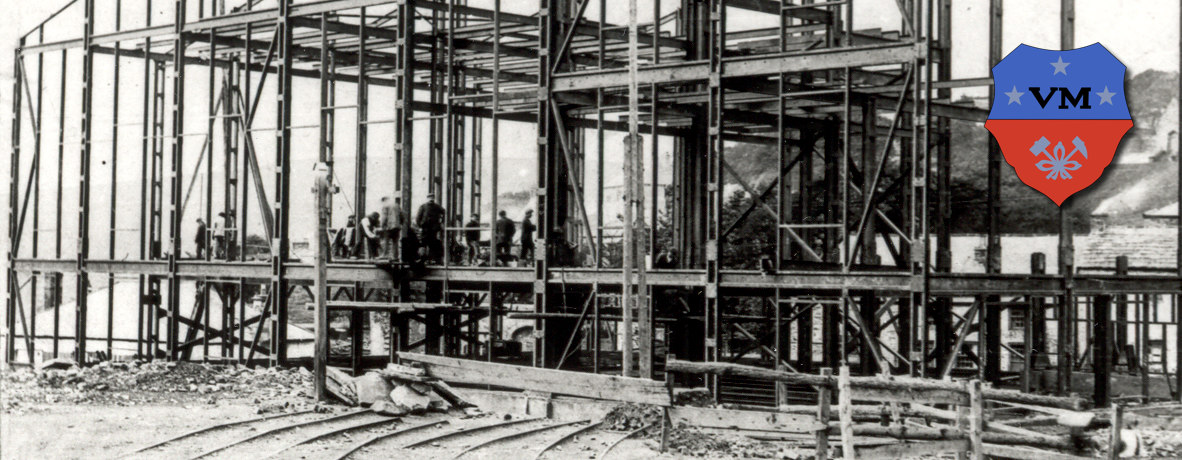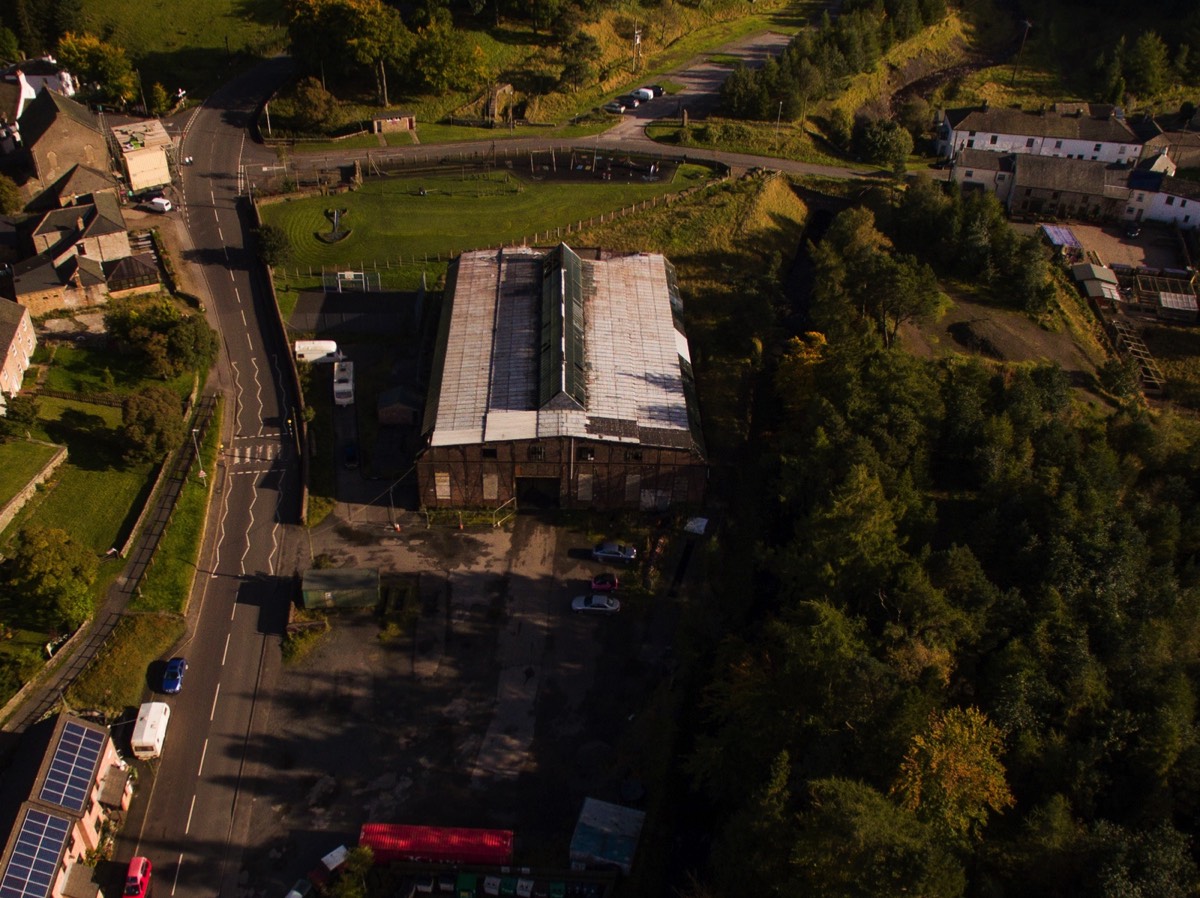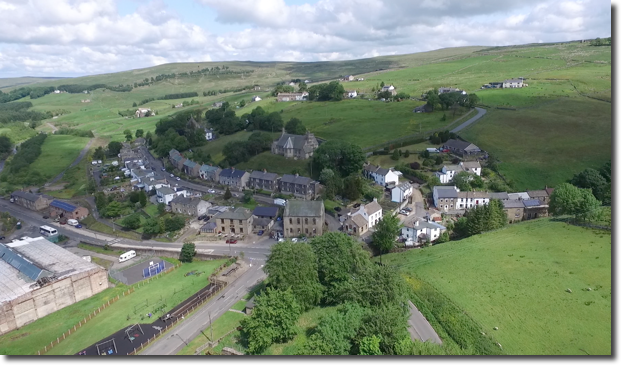IN MEMORIAM – Nenthead Ore Dressing Mill
IN MEMORIAM – Nenthead Ore Dressing Mill
an article by Alastair Robertson

INTRODUCTION
To put everything into context, the village of Nenthead in Cumbria is situated some 35 miles southeast from Carlisle, at the eastern edge of the county, bordering onto Northumberland and County Durham. This region of the north Pennines has been exploited for its metalliferous ores - lead, with its associated silver, zinc, iron and some copper - since Roman times and before. Lead mining on Alston Moor, where Nenthead was the key location, was at its peak during the eighteenth and nineteenth centuries. Then, in the latter part of the nineteenth century, reserves were becoming exhausted and more expensive to extract at a time when cheaper ore began to be imported in quantity from abroad. Zinc, however, had never been properly exploited, in the early 19th century it had been mined locally but never to its full potential until the arrival of the Vieille Montagne Zinc Company of Belgium.
The Societe Anonyme des Mines et Fonderies de Zinc de la Vieille Montagne of Belgium, or VM for short, took over the mineral leases of Alston Moor in 1896, bringing with it many new working practices, new operating techniques, new machinery, a lot of financial investment and a multinational workforce.
In 1905 the old ore-dressing mill in the centre of the village was destroyed by fire, which gave the VM the opportunity to construct a new mill, which became known as the Rampgill Mill.

A ZINC AND LEAD ORE-DRESSING MILL IS BORN
There is a tradition in Nenthead that the framework for the new mill was manufactured by Krupp of Germany, who erected it there as a standard test, then dismantled it and shipped it to Nenthead for the final construction. Unfortunately there is no documentary proof for either of these stories, the last one being most unlikely in the opinion of structural engineers. Enquiries at the State Archive in Liege in Belgium, the University of Liege, the Historisches Archiv Krupp in Germany, and the Vieille Montagne Zinc Company itself, as to the manufacturer have met with no positive result, and the Vieille Montagne office at Nenthead unfortunately suffered a fire in 1930 that destroyed many records.
Although the construction of this enormous building was an important event, it made only a slight stir in one of the local newspapers. The Haltwhistle Echo reported on 23rd April 1909:
“NEW PLANT FOR THE MINES - The Vieille Montagne Zinc Company are busily engaged at present in pulling down their large dressing plant at Rampgill, in order to install new improved plant so that the dressing of the mineral ore can be carried out more successfully. The undertaking will cost the company several thousands.”
Then in the same paper four weeks later: “A REMOVAL - During the week Mr. John Cowing, who has been carrying on business in the centre of the village of Nenthead as grocer and provision merchant, has been removing from his premises, as the shop is to be included in the site which will be occupied by the Vieille Montagne Zinc Company’s new and improved machinery.”
This was followed on 3rd September 1909 with: “INCREASED TRAFFIC - A considerable amount of increased traffic is being conducted on the Nenthead and Alston road at present. Large quantities of building material and plant are being carted every week from Alston Station to Nenthead for the new dressing plant at Rampgill Washing Floor, Nenthead. When completed it will be the largest dressing plant of its kind in the United Kingdom.”
There are no eye witness accounts or photographs of the transportation of the enormous number of cartloads, presumably articulated, of steel stanchions and girders, the length of which could well have caused problems through Alston’s narrow, twisting streets and lanes in the district.
The construction of the new ore-dressing mill involved removing much of the social and commercial centre of the village of Nenthead. The Haltwhistle Echo reported in July 1910 that ‘Peter’, the village clock tower, the butchers’ shambles and the former village school had been demolished. Then, two months later, Mr. Cowing’s shop disappeared as well.
It took a little over a year from the demolition of the old mill to the inauguration, in June 1910, of the new boilers to drive the ore-crushing and washing machinery. After that the VM with its Rampgill Mill was ready for full production. In all, the project had cost over £42,000 at that time, or around £3.25 million today.

THE MILL IN USE, THEN ABANDONED
After the erection of new plant, “the most modern and extensive of its kind erected in the British Isles”, the pre-First World War annual output for the Vieille Montagne was about 2,000 tons of lead and 10,000 tons of ‘blende’, or 60 per cent of the total zinc-ore raised in the whole United Kingdom. In common with other Vieille Montagne mines and dressing mills in Europe, the ore from Alston Moor was not smelted in Britain but shipped via Newcastle to Belgium.
Sadly, within a few years of its commencement, the outbreak of the First World War forced the closure of much of the works, but the government stepped in to provide subsidies for zinc production for home consumption. This assistance kept Rampgill Mill working, which was greatly appreciated by local people as a benefit to the economy of the district. The Nenthead Ward Meeting Minute Book of 19th March 1915 recorded that,
“… in other parts of the country the war had affected certain industries and thereby causing un-employment, but in this our village we still heard the welcome hum of the machinery of the industry that was normal in this little place.”
During the final year of the war, 150 tons of material were being dressed each day, of which only 40 per cent was ore from the mines, which was treated along with the bulk of the material that came from the old waste heaps. The output from the mines was regarded as insufficient and the lack of miners due to the recruitment for the war effort was blamed.
Within a few months after the end of the war, first in March and then in June 1919, the government subsidies were withdrawn. In addition to this, the quality of available ore had deteriorated, while extraction and processing costs had increased by 2½ times since 1914. These circumstances led the Vieille Montagne to close mines and lay off a large percentage of its workforce. By 1921 the only active mines were at Nentsbury Haggs and for a short time at Brownley Hill in the Nent valley, and over on the other side of Alston Moor at Rotherhope. The ore-dressing process was removed from Rampgill Mill to the smaller dressing mill at Nentsbury, a location more convenient to the Haggs mine entrance, so leaving the state-of-the-art Rampgill Mill redundant.
Having worked at almost full capacity since 1910, Rampgill Mill was idle from 1919 throughout most of the 1920’s until the discovery of new lead veins in 1926, and the sinking of Wellhope Shaft over the county boundary into Northumberland, that led to the mill being refurbished and brought back into use.
REFURBISHMENT, ABANDONMENT AND WARTIME USE
In anticipation of processing ore from Wellhope Shaft, Rampgill Mill was re-equipped and modernised with the construction of a new engine house, the installation of two 200 h.p. fuel oil engines for electricity generation, new transmission plant and compressors.
At first, in 1929, the ore from the new sources was transported from Wellhope Shaft to Rampgill Mill via a purpose-built aerial ropeway. But the ropeway failed after less than a year in operation and so the ore was brought out underground via Nentsbury Haggs Mine entrance, again to the smaller dressing mill at Nentsbury and the mill at Rotherhope Mine - not to Rampgill Mill.
This further colossal capital expenditure had to be mostly written off because the prices of lead and zinc remained low, even though there was a slight boost when Britain left the gold standard in the autumn of 1931.
Rampgill ore-dressing mill was no longer needed and once more it went out of use, this time for over a decade until it was taken over by the government during the Second World War. In 1941 the Ministry of Supply, through its Non-Ferrous Ores Committee, in co-operation with the Vieille Montagne, examined several possible sources of lead, zinc and barytes in the area around Nenthead. This was from the point of view of their importance as a war-time measure rather than as a peace-time economic measure. A sample of 100 tons of material from the tailing dams (or waste heaps) was tested, following which the Committee believed that there was the potential for “rapid and certain production on a relatively large scale.” Nenthead was recommended for development and Rampgill Mill was requisitioned. That same year the Ministry of Supply set up the Non-Ferrous Minerals Development Ltd., who, between 22nd January 1942 and 30th June 1943, installed a new flotation plant inside Rampgill Mill, with a capacity of 1,000 tons per day, in order to process material from the tailings dams and from the waste dumps which were also requisitioned.
The process within the mill was highly mechanised, which meant that the company employed only seven men per shift to crush and wash the ore, but:
“… in addition six men, under a charge hand, were engaged daily on the tailings dams, turfing, raising delivery pipes, etc. The remainder of the labour employed included assayer and assistant, engineer and fitting shop staff, and clerical staff, making an average of 56 people employed on the project, excluding, of course, the contractor’s employees.”
The Cumberland and Westmorland Herald reported that:
“In addition the dumps of tailings at Nenthead, estimated at a gross tonnage of 600,000 and preserved because they were known to contain percentages of lead and particularly zinc values, were also to serve the nation in its hour of need.”
Operations commenced on July 19th 1943 with ‘tailings’ from Nentsbury, together with a small output from Rotherhope mine, and finished on November 28th 1945, during which period 564,939 tons of tailings were treated to produce 20,557 tons of 55 per cent zinc concentrates and 1,385 tons of 73 per cent lead concentrates, at a time when zinc was “a disappearing commodity in the world market.”
POST-SECOND WORLD WAR AND CHANGES IN OWNERSHIP
In 1948, the Ministry of Supply derequisitioned the dumps and dismantled and removed its processing plant from Rampgill Mill. The government, however, retained the building which was still owned by the Vieille Montagne.
The mill building on this occasion was empty for only a few years, because, during 1948, the Imperial Smelting Corporation Ltd. became interested in acquiring the mineral leases of Alston Moor. In July that year, after months of negotiation and research, a provisional agreement was reached to convey all the Vieille Montagne interests to the Corporation or its subsidiary, Anglo-Austral Mines, Ltd. The transfer took effect from February 7th 1949.
The Anglo-Austral intended to transport fluorspar and lead ore from Heights Mine in upper Weardale, together with mineral from the old dumps in the Alston area, for processing in a modern flotation plant to be built in Rampgill Mill. This was expected to produce high grade fluorspar concentrates for use in the manufacture of hydrofluoric acid.
The operation lasted until early in 1961 when Heights Mine closed and then, on the 24th January 1962, Anglo-Austral transferred most of their interests, including Rampgill Mill, to a consortium of local miners and mineralogists by the name of ‘Rampgill Mill Limited’.
Much of the Anglo-Austral plant and equipment in the mill was dismantled, but some was retained to be used by Rampgill Mill Limited. However, the new company did not start production until late in 1962 due to unfavourable mineral prices at the time. The machinery in the mill was capable of producing 10 tons of zinc concentrates in 24 hours, which was transported by road to Haydon Bridge, then by rail to Newcastle, from where, perhaps with a touch of nostalgia, it was shipped to Belgium as in the Vieille Montagne days. In addition, the company produced lead at the rate of 1 ton in 24 hours, which was also shipped to Belgium.
In 1963 Rampgill Mill Limited were reported as being “the only producers of zinc concentrates operating today on a commercial basis in the United Kingdom”, but the enterprise did not last much longer. On 13th December 1964 at an extraordinary general meeting a resolution was passed to wind up the company voluntarily and to appoint a liquidator. Then finally, on 3rd October 1967, Rampgill Mill Limited, “in liquidation”, conveyed lower part of the empty mill building (the ‘tower’ section was demolished) to ‘Wright Brothers (Coaches) Limited’ for £500, and in their hands it became ‘Central Garage’, as it remained for fifty years until a few days ago.
R.I.P RAMPGILL MILL / WRIGHT’S BUS DEPOT
(This article has been edited from the Level Three Heritage Asset Statement that accompanied the planning application submitted by the Wright Brothers. For the story of the Vieille Montagne Zinc Company of Belgium on Alston Moor, read ‘The Foreigners in the Hills’ by Alastair F. Robertson, Hundy Publications, 2012.)

Aerial photograph by Simon Love




